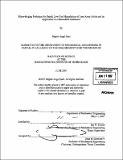Micro-forging technique for rapid, low-cost manufacture of lens array molds and its application in a biomedical instrument
Author(s)
Saez, Miguel Angel
DownloadFull printable version (2.604Mb)
Other Contributors
Massachusetts Institute of Technology. Dept. of Mechanical Engineering.
Advisor
Ian W. Hunter.
Terms of use
Metadata
Show full item recordAbstract
Interest in micro-optical components for applications ranging from telecommunications to the life sciences has driven the need for accessible, low-cost fabrication techniques. Most micro-lens fabrication processes are unsuitable for applications requiring 100% fill factor, apertures around 1 mm, and scalability to large areas with millions of lenses. A flexible, low-cost mold fabrication technique that utilizes a combination of milling and micro-forging is reported. The technique involves first performing a rough cut with a ball-end mill. Final shape and sag height are then achieved by pressing a sphere of equal diameter into the milled divot. Using this process, molds were fabricated for rectangular arrays of 1-10,000 lenses with apertures of 0.25-1.6 mm, sag heights of 3-130 [mu]m, inter-lens spacings of 0.25-2 mm, and fill factors of 0-100%. Mold profiles have roughness and figure error of 68 nm and 354 nm, respectively, for 100% fill factor, 1 mm aperture square lenses. The required forging force was modeled as a modified open-die forging process and experimentally verified to increase nearly linearly with surface area. (cont.) The optical performance of lens arrays injection molded from micro-forged molds was characterized by imaging the point spread function, and was found to be in the range of theoretical values. Limitations include milling machine range and accuracy. Application to biological fluorescence detection in a biomedical device is also reported.
Description
Thesis (S.B.)--Massachusetts Institute of Technology, Dept. of Mechanical Engineering, 2007. Includes bibliographical references (leaves 46-48).
Date issued
2007Department
Massachusetts Institute of Technology. Department of Mechanical EngineeringPublisher
Massachusetts Institute of Technology
Keywords
Mechanical Engineering.